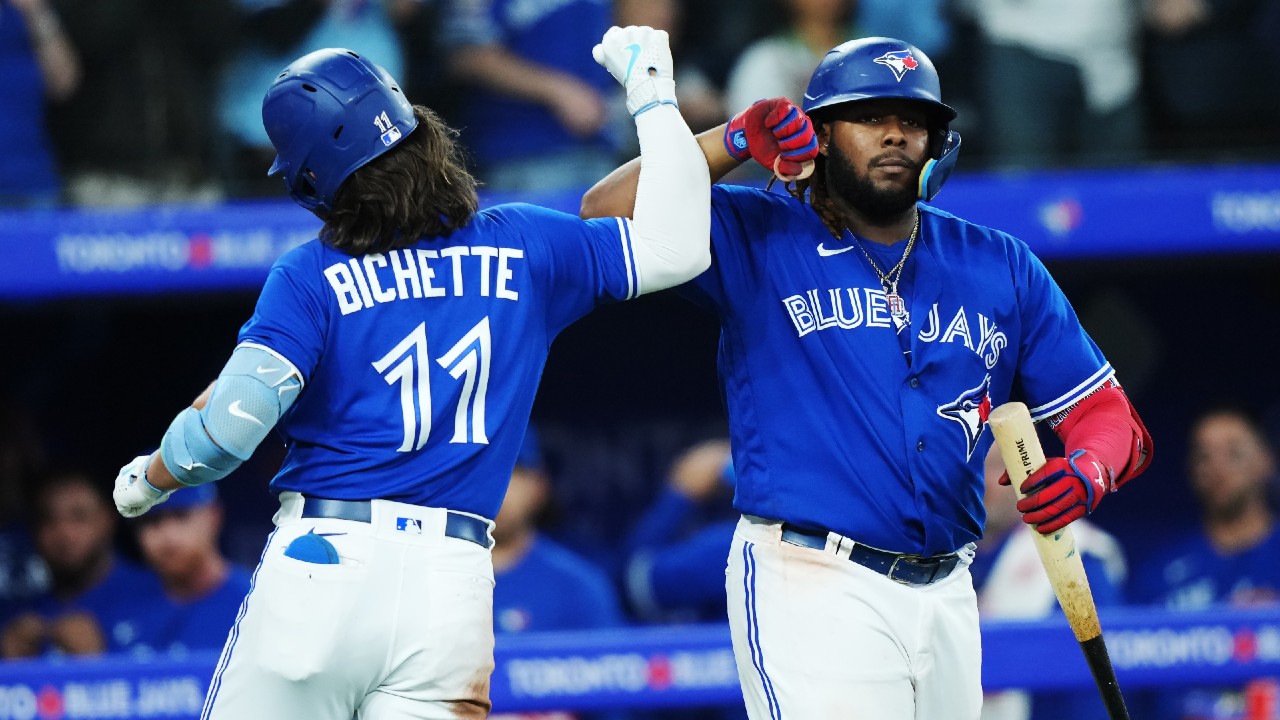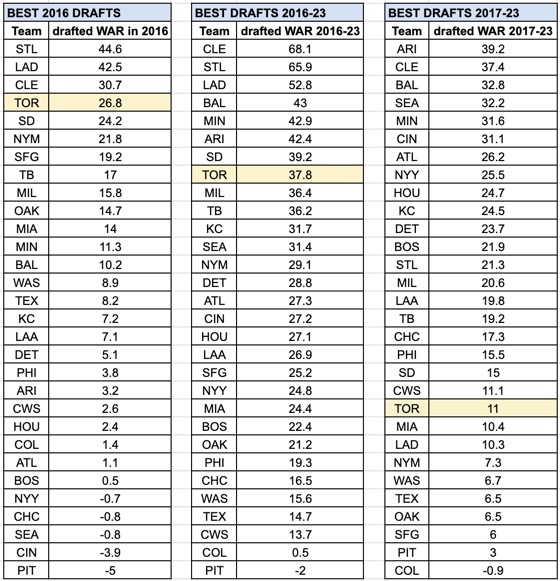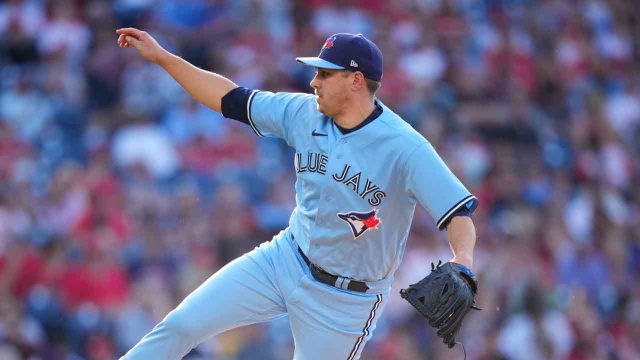TORONTO — This coming Sunday, Ross Atkins will oversee his ninth draft as Blue Jays general manager and, as always, the stakes are high.
There’s simply no better avenue for adding high-impact players than the draft, which is also an ideal way to acquire the prospects who tempt other teams in trades and the relievers and bench players who round out a roster.
Draft well, like the Guardians or Orioles, and you can succeed even with modest payrolls. Draft poorly, like the Rockies or White Sox, and you’re in trouble.
The MLB draft is only the first step domestic players take on their way to the major leagues. Developing them into big leaguers takes coaching, resources and patience. But the draft itself is an essential part of that process, which is why teams devote so much energy to it year-round.
So, have the Blue Jays drafted well under Atkins? It’s an evolving answer, of course, but there’s already enough information to draw some conclusions about the drafting record of this current front office. They started well — exceptionally well, in fact — and thanks in large part to one great pick, they rank eighth in MLB with 37.8 in total WAR drafted since 2016. But over the last seven years, the results place the Blue Jays among the bottom third of teams, and there’s a direct connection between those shortcomings and the current struggles of the big-league team.
“It’d be difficult to give any sort of grade,” said amateur scouting director Shane Farrell, who’s about to conduct his fifth draft with the Blue Jays. “We’re always learning and evolving from each draft class. There’s things we’ve done well, and I’m sure there are things we could improve upon (or) that we have improved on. I think where we have been successful is supplying the organization with picks that have impacted our major-league team, whether they’re playing in our uniforms or they’ve allowed us to go out and acquire guys like Matt Chapman or (Jose) Berrios and push us into the playoffs.”
var adServerUrl = “”;
var $el = $( “#video_container-785843” );
var permalink = $el.closest(‘.snet-single-article’).data(‘permalink’);
/*
if ( “1” == true && ‘undefined’ !== typeof window.getIndexAds ) {
var so = preroll:1:1:siteID:191888,2:siteID:191889;
adServerUrl = window.getIndexAds( ‘ so, permalink);
} else
adServerUrl = ”
*/
adServerUrl = ”
var adServerUrl_result = adServerUrl.includes(“cust_params”);
var queryString=”;
if(adServerUrl_result)
var gettheDUFI = localStorage.getItem(“theRED_loc”)
if(gettheDUFI)
queryString += “dufiid=” + gettheDUFI + ‘&’;
queryString += “ppid=” + gettheDUFI + ‘&’;
var ppid = “ppid=” + gettheDUFI + ‘&’;
var DUFI_IP = sessionStorage.getItem(“DUFI_IP”)
if(DUFI_IP)
queryString += “dufiip=” + DUFI_IP + ‘&’;
adServerUrl = adServerUrl.replace(/cust_params=/, ppid + ‘cust_params=” + encodeURIComponent(queryString) );
$el.after( unescape(“%3Cscript src=\”” + (document.location.protocol == “https:” ? ” : ” + “.scorecardresearch.com/beacon.js\” %3E%3C/script%3E”) );
$( document ).one( “ready’, function()
$( “#video_container-785843” ).SNPlayer(
bc_account_id: “1704050871”,
bc_player_id: “JCdte3tMv”,
//autoplay: true,
//is_has_autoplay_switch: false,
bc_videos: 6357462606112,
is_has_continuous_play: “false”,
adserverurl: adServerUrl,
section: “”,
thumbnail: ”
direct_url: ”
);
);
var adServerUrl = “”;
var $el = $( “#video_container-402141” );
var permalink = $el.closest(‘.snet-single-article’).data(‘permalink’);
/*
if ( “1” == true && ‘undefined’ !== typeof window.getIndexAds ) {
var so = preroll:1:1:siteID:191888,2:siteID:191889;
adServerUrl = window.getIndexAds( ‘ so, permalink);
} else
adServerUrl = ”
*/
adServerUrl = ”
var adServerUrl_result = adServerUrl.includes(“cust_params”);
var queryString=”;
if(adServerUrl_result)
var gettheDUFI = localStorage.getItem(“theRED_loc”)
if(gettheDUFI)
queryString += “dufiid=” + gettheDUFI + ‘&’;
queryString += “ppid=” + gettheDUFI + ‘&’;
var ppid = “ppid=” + gettheDUFI + ‘&’;
var DUFI_IP = sessionStorage.getItem(“DUFI_IP”)
if(DUFI_IP)
queryString += “dufiip=” + DUFI_IP + ‘&’;
adServerUrl = adServerUrl.replace(/cust_params=/, ppid + ‘cust_params=” + encodeURIComponent(queryString) );
$el.after( unescape(“%3Cscript src=\”” + (document.location.protocol == “https:” ? ” : ” + “.scorecardresearch.com/beacon.js\” %3E%3C/script%3E”) );
$( document ).one( “ready’, function()
$( “#video_container-402141” ).SNPlayer(
bc_account_id: “1704050871”,
bc_player_id: “JCdte3tMv”,
//autoplay: false,
//is_has_autoplay_switch: false,
bc_videos: 6357462606112,
is_has_continuous_play: “false”,
adserverurl: adServerUrl,
section: “”,
thumbnail: ”
direct_url: ”
);
);
Meanwhile, some others in the industry aren’t impressed by the team’s recent draft record.
“It’s not good,” countered one longtime scout with no affiliation to the current front office.
In 2016, the first summer under Shapiro and Atkins, the Blue Jays had an objectively strong draft. Not only did they select Bo Bichette, who ranks sixth in wins above replacement among all players drafted since 2016, they added Cavan Biggio in the fifth round — an excellent choice at 162nd overall. Assigning credit gets convoluted, since area scout Matt Bishoff pushed for Bichette, amateur scouting director Brian Parker made the selection and Atkins oversaw it all, but from Bishoff to Parker to Atkins, everyone wanted the shortstop with the unorthodox swing.
As preparation for that draft unfolded, though, tension emerged between Parker and the new Blue Jays front office, according to sources. It wasn’t just that the sides liked different players, but they also had different ways of doing things. Parker had already established a method that had worked for him while overseeing three drafts in Toronto and selecting the likes of Danny Jansen, Jordan Romano and Kendall Graveman. Maybe that would have earned him leeway elsewhere, yet the Blue Jays had a different vision.
At that point, Atkins and team president Mark Shapiro were intent on modernizing the Blue Jays’ approach to drafting by implementing a system that would incorporate data and ideally get stronger over time. As this contrast emerged, some high-ranking Blue Jays people started bristling at Parker’s methods. That August, Atkins fired Parker, who’s now the senior director of international scouting for the Angels.
It was a decision Atkins evidently felt would benefit the organization long-term, but the timing was awkward, as Parker was dismissed after what would soon reveal itself as an excellent draft. Eight years later, there’s no debating this much: the Blue Jays did well in 2016. By total WAR drafted, the Cardinals (Tommy Edman and Zac Gallen), Dodgers (Will Smith, Tony Gonsolin, Gavin Lux and Dustin May) and Guardians (Shane Bieber, Aaron Civale, Nolan Jones and Zach Plesac) were best in MLB that year. The Blue Jays were right behind them, ranking fourth in baseball.
After dismissing Parker in August of 2016, the Blue Jays hired Steve Sanders as amateur scouting director and he’d oversee their next three drafts before being hired as the Pirates’ assistant GM late in 2019. At that point, the Blue Jays hired Farrell, who’s been in place since. Both scouting directors are well regarded within the industry, but it was also a lot of transition in a short period of time, and sources both within and outside of the organization believe there was a cost to that change, as established methods were overturned for new ones and trusted scouts like Bishoff and Jamie Lehman left the Blue Jays.
var adServerUrl = “”;
var $el = $( “#video_container-660416” );
var permalink = $el.closest(‘.snet-single-article’).data(‘permalink’);
/*
if ( “1” == true && ‘undefined’ !== typeof window.getIndexAds ) {
var so = preroll:1:1:siteID:191888,2:siteID:191889;
adServerUrl = window.getIndexAds( ‘ so, permalink);
} else
adServerUrl = ”
*/
adServerUrl = ”
var adServerUrl_result = adServerUrl.includes(“cust_params”);
var queryString=”;
if(adServerUrl_result)
var gettheDUFI = localStorage.getItem(“theRED_loc”)
if(gettheDUFI)
queryString += “dufiid=” + gettheDUFI + ‘&’;
queryString += “ppid=” + gettheDUFI + ‘&’;
var ppid = “ppid=” + gettheDUFI + ‘&’;
var DUFI_IP = sessionStorage.getItem(“DUFI_IP”)
if(DUFI_IP)
queryString += “dufiip=” + DUFI_IP + ‘&’;
adServerUrl = adServerUrl.replace(/cust_params=/, ppid + ‘cust_params=” + encodeURIComponent(queryString) );
$el.after( unescape(“%3Cscript src=\”” + (document.location.protocol == “https:” ? ” : ” + “.scorecardresearch.com/beacon.js\” %3E%3C/script%3E”) );
$( document ).one( “ready’, function()
$( “#video_container-660416” ).SNPlayer(
bc_account_id: “1704050871”,
bc_player_id: “JCdte3tMv”,
//autoplay: true,
//is_has_autoplay_switch: false,
bc_videos: 6357430263112,
is_has_continuous_play: “false”,
adserverurl: adServerUrl,
section: “”,
thumbnail: ”
direct_url: ”
);
);
var adServerUrl = “”;
var $el = $( “#video_container-822789” );
var permalink = $el.closest(‘.snet-single-article’).data(‘permalink’);
/*
if ( “1” == true && ‘undefined’ !== typeof window.getIndexAds ) {
var so = preroll:1:1:siteID:191888,2:siteID:191889;
adServerUrl = window.getIndexAds( ‘ so, permalink);
} else
adServerUrl = ”
*/
adServerUrl = ”
var adServerUrl_result = adServerUrl.includes(“cust_params”);
var queryString=”;
if(adServerUrl_result)
var gettheDUFI = localStorage.getItem(“theRED_loc”)
if(gettheDUFI)
queryString += “dufiid=” + gettheDUFI + ‘&’;
queryString += “ppid=” + gettheDUFI + ‘&’;
var ppid = “ppid=” + gettheDUFI + ‘&’;
var DUFI_IP = sessionStorage.getItem(“DUFI_IP”)
if(DUFI_IP)
queryString += “dufiip=” + DUFI_IP + ‘&’;
adServerUrl = adServerUrl.replace(/cust_params=/, ppid + ‘cust_params=” + encodeURIComponent(queryString) );
$el.after( unescape(“%3Cscript src=\”” + (document.location.protocol == “https:” ? ” : ” + “.scorecardresearch.com/beacon.js\” %3E%3C/script%3E”) );
$( document ).one( “ready’, function()
$( “#video_container-822789” ).SNPlayer(
bc_account_id: “1704050871”,
bc_player_id: “JCdte3tMv”,
//autoplay: false,
//is_has_autoplay_switch: false,
bc_videos: 6357430263112,
is_has_continuous_play: “false”,
adserverurl: adServerUrl,
section: “”,
thumbnail: ”
direct_url: ”
);
);
As scouting directors, Sanders and Farrell each worked on two fronts: first, to identify and sign the best amateur players and alongside that, to help build out a comprehensive model designed to benefit the organization long-term. It’s what successful teams like the Guardians, Rays and Dodgers do, and it’s designed to benefit the Blue Jays over time.
Whatever its long-term benefits may be, though, this process has yet to produce many good big-league players or top prospects.
“There’s obviously a need and a desire to keep backfilling with internal prospects,” Farrell said. “This draft allows us to do so. And we’re looking forward to that opportunity.”
Assessing more recent drafts is challenging, since dozens of Blue Jays prospects who will eventually contribute at the MLB level are still developing in the minor leagues. With that in mind, two categories need to be considered: MLB contributions to date and current farm system rankings. The Blue Jays lag behind in both.
When it comes to production on the field from drafted players, the spread between teams is massive. On the low end, the Rockies have actually had negative WAR from drafted players since 2017, and the Pirates were on that precipice too before the emergence of Paul Skenes. On the high end, teams like the Diamondbacks, Guardians and Orioles have all enjoyed recent success despite ranking in the bottom half of MLB payrolls.
As for the Blue Jays, they rank 21st among the 30 teams in WAR drafted since 2017 with 11.0, right between the White Sox and the Marlins (all numbers through July 5, 2024; only players who signed were counted so, for instance, Adley Rutschman doesn’t help the Mariners’ WAR total; teams do get credit for MLB WAR accrued by players they’d later trade).
If you go back to 2016 and include Bichette, the Blue Jays rank second in the division behind Baltimore in WAR drafted. But since that organizational inflection point of 2017, Toronto ranks last in the AL East, trailing the Orioles (32.8 WAR), Yankees (25.5), Red Sox (21.9) and Rays (19.2) by a substantial margin.
Now, if the Blue Jays had a top-ranked farm system, that modest WAR total would be easier to overlook. Yet the Blue Jays’ farm system began the season ranked 23rd by FanGraphs and 24th by both Baseball America and MLB.com. Since then, those rankings haven’t likely improved, as many of the organization’s top prospects have been sidelined via injury (Ricky Tiedemann, Brandon Barriera, Landen Maroudis) and suspension (Orelvis Martinez), overshadowing steps forward by the likes of Arjun Nimmala.
Asked what the Blue Jays do best, Farrell pointed to the refinement of the team’s methodology. He said the team’s scouting department is “constantly thinking” about how to improve and “continuously reflecting” on how to make better decisions.
“I think it’s probably continuing to improve our own internal processes,” Farrell said. “The way that that we’re deploying our scouts and the way that we’re connecting with our player development and bringing those two sides together to form a path and a plan for each potential amateur prospect.”
By way of example, Farrell pointed to former big-league pitcher Frank Herrmann, who has been playing a more active role in pitching evaluations this year than he did in the past. The hope is, that’s an adjustment that pays off with better picks.
Of course, the strength or weakness of a farm system depends on more than just the draft, as international signings and player development have a significant impact, too. The international market’s the other way to find a homegrown superstar, though the time horizons there are even longer. But either way, publicly available prospect lists suggest the Blue Jays aren’t sitting on a cache of prospects destined for the big leagues.
When the topic of the draft comes up, Blue Jays people including Farrell will point out that they flipped former first-round picks like Austin Martin, Gunnar Hoglund and Jordan Groshans for major-league players such as Berrios, Chapman and Zach Pop — and that’s true. Those trades all worked out, while the prospects haven’t.
var adServerUrl = “”;
var $el = $( “#video_container-253893” );
var permalink = $el.closest(‘.snet-single-article’).data(‘permalink’);
/*
if ( “1” == true && ‘undefined’ !== typeof window.getIndexAds ) {
var so = preroll:1:1:siteID:191888,2:siteID:191889;
adServerUrl = window.getIndexAds( ‘ so, permalink);
} else
adServerUrl = ”
*/
adServerUrl = ”
var adServerUrl_result = adServerUrl.includes(“cust_params”);
var queryString=”;
if(adServerUrl_result)
var gettheDUFI = localStorage.getItem(“theRED_loc”)
if(gettheDUFI)
queryString += “dufiid=” + gettheDUFI + ‘&’;
queryString += “ppid=” + gettheDUFI + ‘&’;
var ppid = “ppid=” + gettheDUFI + ‘&’;
var DUFI_IP = sessionStorage.getItem(“DUFI_IP”)
if(DUFI_IP)
queryString += “dufiip=” + DUFI_IP + ‘&’;
adServerUrl = adServerUrl.replace(/cust_params=/, ppid + ‘cust_params=” + encodeURIComponent(queryString) );
$el.after( unescape(“%3Cscript src=\”” + (document.location.protocol == “https:” ? ” : ” + “.scorecardresearch.com/beacon.js\” %3E%3C/script%3E”) );
$( document ).one( “ready’, function()
$( “#video_container-253893” ).SNPlayer(
bc_account_id: “1704050871”,
bc_player_id: “JCdte3tMv”,
//autoplay: true,
//is_has_autoplay_switch: false,
bc_videos: 6357422587112,
is_has_continuous_play: “false”,
adserverurl: adServerUrl,
section: “”,
thumbnail: ”
direct_url: ”
);
);
var adServerUrl = “”;
var $el = $( “#video_container-938675” );
var permalink = $el.closest(‘.snet-single-article’).data(‘permalink’);
/*
if ( “1” == true && ‘undefined’ !== typeof window.getIndexAds ) {
var so = preroll:1:1:siteID:191888,2:siteID:191889;
adServerUrl = window.getIndexAds( ‘ so, permalink);
} else
adServerUrl = ”
*/
adServerUrl = ”
var adServerUrl_result = adServerUrl.includes(“cust_params”);
var queryString=”;
if(adServerUrl_result)
var gettheDUFI = localStorage.getItem(“theRED_loc”)
if(gettheDUFI)
queryString += “dufiid=” + gettheDUFI + ‘&’;
queryString += “ppid=” + gettheDUFI + ‘&’;
var ppid = “ppid=” + gettheDUFI + ‘&’;
var DUFI_IP = sessionStorage.getItem(“DUFI_IP”)
if(DUFI_IP)
queryString += “dufiip=” + DUFI_IP + ‘&’;
adServerUrl = adServerUrl.replace(/cust_params=/, ppid + ‘cust_params=” + encodeURIComponent(queryString) );
$el.after( unescape(“%3Cscript src=\”” + (document.location.protocol == “https:” ? ” : ” + “.scorecardresearch.com/beacon.js\” %3E%3C/script%3E”) );
$( document ).one( “ready’, function()
$( “#video_container-938675” ).SNPlayer(
bc_account_id: “1704050871”,
bc_player_id: “JCdte3tMv”,
//autoplay: false,
//is_has_autoplay_switch: false,
bc_videos: 6357422587112,
is_has_continuous_play: “false”,
adserverurl: adServerUrl,
section: “”,
thumbnail: ”
direct_url: ”
);
);
But while the Blue Jays got value by trading their picks, they didn’t actually draft players who ended up producing at a high level in the majors, and none of that reflects well on their collective ability to identify impact talent or develop it. Their list of first-round picks since 2016 includes more misses than hits: T.J. Zeuch, Nate Pearson, Logan Warmoth, Groshans, Alek Manoah, Martin, Hoglund, Barriera and Nimmala. While every team whiffs in the draft, the Blue Jays have missed more than most lately.
The lack of impact from the draft is especially apparent when it comes to pitching. Since 2016, the Blue Jays have drafted only two pitchers who have generated at least 2.0 career WAR: Manoah, who was a 2022 Cy Young finalist before struggling in 2023 and undergoing season-ending elbow surgery this summer, and Josh Winckowski, a 2016 15th-round pick who was traded to the Mets in the Steven Matz deal before finding some success with the Red Sox.
While the Blue Jays have done well signing free agent starting pitching, sustained success depends on internal contributions as well. Since 2016, the Blue Jays haven’t had seen enough of their draft picks emerge as MLB contributors.
Pair that with a complete absence of international pitching developed over the same period and it’s a major organizational shortcoming. And regardless of how they got here, this is not where the Blue Jays expected to be. In 2015, months after taking over as team president, Shapiro remarked on what he perceived as a lack of minor-league depth built by his predecessor, Alex Anthopoulos.

“There were five (triple-A) guys named blank,” Shapiro said at the time. “The guys named blank don’t contribute many innings. We had to deal with that challenge and we’re creatively trying to address it.”
Eight and a half years later, though, the Blue Jays found themselves using reliever Trevor Richards as a stopgap starting pitcher for the second year in a row — not a position they would have been in if they had developed minor-league pitchers they trust. Ideally, the Blue Jays would have had optionable arms capable of filling in those gaps, but that simply hasn’t been the case.
As a collective, their pitching staff ranks 22nd in MLB with a 4.32 ERA. Due in part to their pitching issues, the Blue Jays are now 41-50 with 1.9 per cent playoff odds, according to FanGraphs.
With all this in mind, there’s a clear connection between the lack of production from the draft and the current state of the organization. The Blue Jays’ way of doing things may well be better now, but they need that to translate into better players and prospects. On Sunday, the ninth draft under the current front office, a precious chance will emerge to find more talent at the amateur level. The organization certainly needs the boost.



